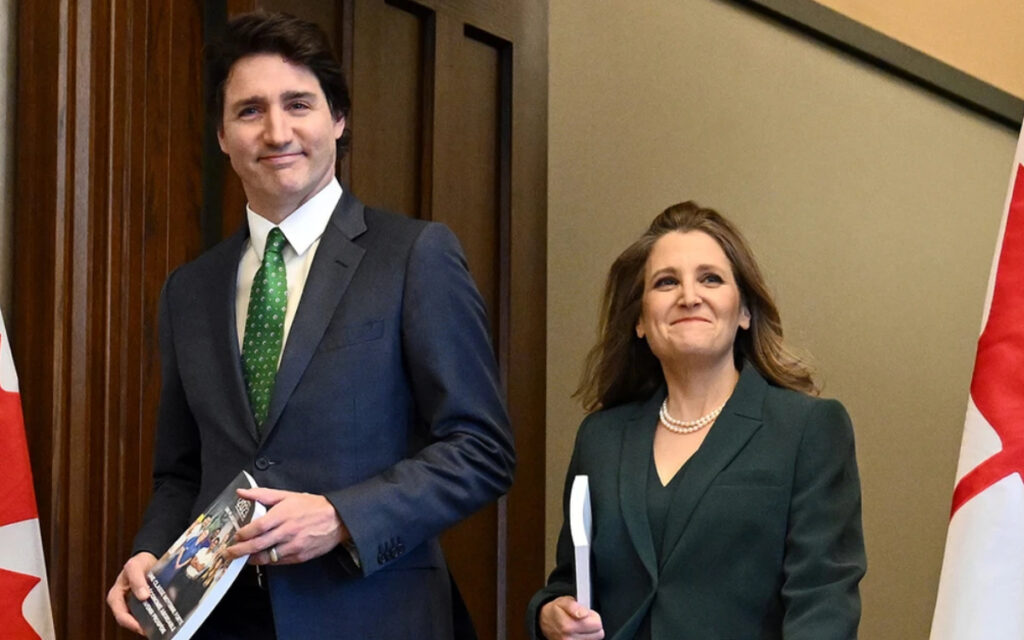
After eight years of the Trudeau Liberal government managing the Canadian economy, Canadians are in the throes of a cost-of-living crisis. While this crisis is being felt by citizens in countries around the world, the Trudeau government’s policies are exacerbating the tight financial situation most Canadians find themselves in. Pictured are Prime Minister Justin Trudeau and Finance Minister Chrystia Freeland. Photo Credit: Justin Tang/The Canadian Press.
After eight years of the Trudeau Liberal government managing the Canadian economy, Canadians are in the throes of a cost-of-living crisis. While this crisis is being felt by citizens in countries around the world, the Trudeau government’s policies are exacerbating the tight financial situation most Canadians find themselves in. Prime Minister Justin Trudeau, Finance Minister Chrystia Freeland, and a host of senior ministers are championing fiscal and economic policies that are proving to be detrimental to the economic well-being of individual Canadians and of the country as a whole.
The news of an increase in the country’s inflation rate this week is an indication that the government’s current efforts to curtail inflation are falling short. Statistics Canada reported that inflation ticked up in December and the annual rate for 2023 was 3.9 per cent (the second highest annual rate increase in 40 years; 6.8 per cent in 2022 was the highest). Last year, food prices rose by 7.8 per cent, the mortgage interest cost index rose 28.5 per cent, renters paid 6.5 per cent more, and the prices of health and personal care products rose faster in 2023 than the prior year.
Financial analysis of the increases in cost of living and the stubbornly high inflation rate suggests the federal government’s policies are in fact driving inflationary pressure. Economists Jake Fuss and Jason Clemens of the Fraser Institute state: “Large increases in spending, taxes, and borrowing have not translated into a more robust economy.” They conclude that Canadians “can thank Trudeau’s policies for our stagnant economy and deteriorating federal finances.”
Here is the toxic mix of Trudeau government’s policies that are making all aspects of life more expensive.
The carbon tax (and increased taxes)
The carbon tax increases the cost of everything in Canada. The Trudeau government’s schedule of carbon tax hikes is hurting Canadian individuals, families, and the nation’s economy. This punitive tax policy, expressly designed to alter Canadians’ behaviour and energy habits, is not only adding tax onto gas and home heating fuel, but it is a tax on all goods and services. It hits farmers and truckers hard and it hits commuters – twice a day. Homeowners stress about heat and families stress about meals for their kids. It adds to the cost of a Tim Hortons’ coffee, food in your grocery cart, and housing construction costs. Everything is impacted by this tax. And Bank Governor Tiff Macklem confirmed in a parliamentary committee hearing that the carbon tax is responsible for at least 16 per cent of country’s total inflation rate.
With the carbon tax piled on top of a litany of government taxes, Canadians now pay nearly half of their income (46 per cent) in taxes. According to the Fraser Institute, our tax bills are the fastest growing expenditure for working Canadians, more than the rising costs of housing, food and clothing combined. This tax burden is a significant challenge for Canada to attract and retain entrepreneurs, investors and skilled professionals. Even more serious is the rising taxes on middle-class Canadians, 86 per cent of whom are paying higher personal income taxes today than when Trudeau took office in 2015.
Unbridled government spending
The Trudeau government’s record of consecutive budget deficits is pockmarked with unbridled spending on bureaucracy, and new and expanding government programs. Since Trudeau took the reins of government, annual spending has ballooned 75 per cent (projected to be $453 billion in 2023-24). The federal debt has more than doubled to $1.2 trillion (2022-23) and is projected to rise further to $2.4 trillion within five years. The Trudeau years epitomize big government: the federal public service has grown 40 per cent (now totaling 357,247) and operational spending has increased 32 per cent. Ottawa is washed in a sea of red ink.
With interest costs on the national debt reaching more than $52 billion annually, the billion dollars a week Canadians now spend to service the debt is taking away from the government’s ability to support the increasing demands for improved health care, housing, and social programs.
David Dodge, former governor of the Bank of Canada, told MPs last fall that Canadians face a bleak future of higher taxes and diminished government services as a result of the Trudeau government’s fiscal approach. Dodge commented: “Attempting to finance all these investments by borrowing is resulting in an increase in prices and interest rates and will continue to do so at least over the next decade… The burden of past debt will increase year after year. Governments cannot borrow their way out of these difficult choices.”
No strategy to address Canada’s sagging economy
News on Canada’s sagging economy is as bad as it can get. According to the Organization for Economic Co-operation and Development (OECD), Canada will be the worst-performing advanced economy through the 2020s and for the following three decades. Canada is the only G7 nation to not yet rebound to its pre-pandemic standard of living and is near bottom of the OECD rankings for GDP growth.
Sadly, the OECD projects that growth in living standards in Canada will be the worst of all developed member-countries through 2060. In commenting on these latest projections, the Canadian Coalition for a Better Future testified this past fall before a parliamentary committee: “On a per capita basis, our economy is not only stalled, it’s actually contracting… If things don’t change, we’ll soon be talking about a lost decade of productivity.”
The growing gap in productivity between Canadian and American or EU workers forecasts Canadians’ standard of living falling further behind our neighbours to the south and within Europe. The stakes are great for younger Canadians wanting the same life opportunities as previous generations. Yet to date, the Trudeau government has failed to gain the confidence of the domestic business community or the foreign investment community – and this is now an urgent policy matter in Ottawa.
There has already been suggestions in the international community that Canada is poised to become the next “Greece,” a country debilitated with low growth and high debt. Lakehead economic professor Livio Di Matteo sums it up in this manner: “At [current] rates of growth, in a quarter century, Canada’s real per capita GDP will be 60 percent that of the U.S. We are on track to becoming a relatively poorer country with a more fractious political system that seems unable to get things done.”
Increased immigration
In the last month there has been a great deal of commentary on the Trudeau government’s mismanagement of the immigration file. Despite officials’ warnings of the negative implications for housing affordability and settlement services, the Trudeau government opened the borders of the country to allow for the largest intake of foreigners since Confederation, and greatest number of third-world migrants in the world, resulting in the greatest population growth rate of any G7 country, and greater than China and India.
In the weeks ahead the government will be hard pressed to address the serious impact these burgeoning immigration numbers has had on Canada’s housing market, health care and social services – and, ultimately, on Canadians’ standard of living.
As explained this week by National Bank economists Stefane Marion and Alexandra Ducharme, Canada is now ensnarled in a “population trap.” In the simplest terms, a population trap occurs when a country’s population is growing faster than its economic growth. Tony Keller of the Globe and Mail explained it best: “In plain English, the number of forks in the economic pie is growing faster than the pie, and faster than our capacity to invest in more ovens to bake more pie.”
A final thought
Canadians are feeling the consequences of the Trudeau government’s undisciplined tax-and-spend approach and its damaging economic and immigration policies. In his regular Hill Times column, the thoughtful and often optimistic David Crane provides a snapshot of the current state of the nation. Crane writes of the mood of young Canadians caught up in the affordability crisis: “Too many people are frustrated by lack of housing, cost-of-living crises, and a fear that nothing is about to improve for them. For younger Canadians the future is especially troubling. This is a world of despair, not hope.”

Chris George is an advocate, government relations advisor, and writer/copy editor. As president of a public relations firm established in 1994, Chris provides discreet counsel, tactical advice and management skills to CEOs/Presidents, Boards of Directors and senior executive teams in executing public and government relations campaigns and managing issues. Prior to this PR/GR career, Chris spent seven years on Parliament Hill on staffs of Cabinet Ministers and MPs. He has served in senior campaign positions for electoral and advocacy campaigns at every level of government. Today, Chris resides in Almonte, Ontario where he and his wife manage www.cgacommunications.com. Contact Chris at chrisg.george@gmail.com.




















